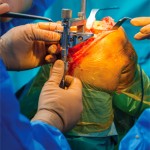Importantly, when patients transition from one care setting to another (e.g., when they leave the acute hospital setting and continue their rehabilitation in an outpatient clinic), clinicians and patients need a common language to communicate progress. Thus, recovery can be tracked more accurately when patients, therapists and other health professionals have a standardized set of outcome measurement tools to identify and record changes in progress.
The Problem with Outcome Measures
Despite the obvious benefits of using outcome measures routinely after joint arthroplasty, in reality, practice falls considerably short of expectations.5 Our team is acutely aware of some of the challenges of fully adopting outcome measures into clinical practice.3,6
A recent systematic review highlights some of the common barriers to using outcome measures and considers why they have not yet been fully or routinely adopted into clinical practice:3 Although clinicians appreciate the value of outcome measures, practically, they find the decision-making process of selecting appropriate outcome measures confusing and intimidating.1,5 A dizzying array of outcome measures is described in the literature, yet in order to be clinically useful, each measure must have appropriate psychometric properties for that patient population and particular phase of recovery. One of the main reasons why clinicians are reluctant to use outcome measures is a lack of knowledge regarding what specific tool to use and at what stage.6
Thus, one goal of the TJAOM knowledge translation team included targeting and tailoring strategies, addressing the barriers identified by clinicians and making it easier to implement outcome measures into routine practice. To be successful, we realized that clinicians needed freely available and easily accessible resources in the clinic, removing the onus of determining which outcome measures are most suitable for each particular phase of recovery.
What’s in the Toolkit?
The TJAOM Toolkit includes:
- A summary of the recommended outcome measures (both patient-reported and performance measures) appropriate for each phase of the joint arthroplasty continuum; and
- Two formats of information to assist clinicians in selecting, administering, scoring and interpreting each measure:
- one-page written summaries and
- online interactive learning modules.
The TJAOM online learning modules were developed in cooperation with The Centre of Excellence for Simulation, Education and Innovation (CESEI) and provide the key points (with videos) on 12 patient-reported and performance-based outcome measures recommended for patients with total joint arthroplasty.7 The learning modules are freely available by creating an account at TJAOM, which will provide you with unlimited free access to the video resources within seven days of registration.


